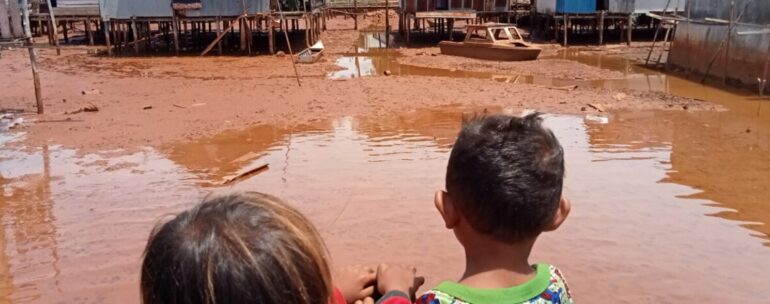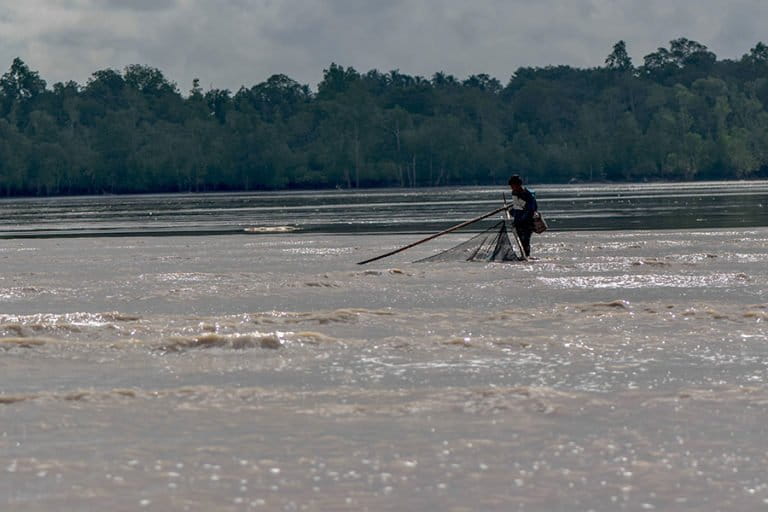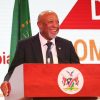Omanyano ovanhu koikundaneki yomalungula kashili paveta, Commisiner Sakaria takunghilile
Veronika Haulenga
Omanyano ovanhu koikundaneki yomalungula kashili paveta, Commisiner Sakaria takunghilile
Veronika Haulenga
Listeners:
Top listeners:
-
play_arrow
Omanyano ovanhu koikundaneki yomalungula kashili paveta, Commisiner Sakaria takunghilile Veronika Haulenga
At-risk groups in Indonesia demand greater say in climate policymaking


By Hans Nicholas Jong, via Mongabay
Civil society groups and communities most affected by the effects of climate change are calling on the Indonesian government to include them in the decision-making process of climate policies.
Groups such as those representing the urban poor and the disabled say they haven’t been meaningfully involved in the process, particularly the drafting of Indonesia’s revised goals and commitments for reducing greenhouse gas emissions under the 2015 Paris Agreement.
Every country that has signed up to the Paris climate deal must submit a list of these commitments, known as its nationally determined contribution, or NDC, and update it every five years. This is crucial to ensuring that each country’s efforts align with the global goal of limiting global temperature rise to 1.5° Celsius (2.7° Fahrenheit) above pre-industrial levels.
The Indonesian government submitted its first NDC in 2015, and has since updated it twice. In the revision, it has raised its emissions reduction target, which now stands at 31.89% by 2030 with its own efforts, or 53.2% with international support.
The government is now revising its NDC for the third time. The submission deadline is February 2025, but the government says it aims to submit the document to the United Nations Framework Convention on Climate Change, or UNFCCC, by the end of this year. The Ministry of Environment and Forestry, the government entity in charge of drafting the NDC, said the latest document will contain a number of improvements, such as accounting for new greenhouse gases.
However, in an open letter addressed to the minister, Siti Nurbaya Bakar, a group of 32 NGOs criticized the process. They said the government had failed to meaningfully involve civil society groups and at-risk communities in the decision-making process.
“This second NDC document from Indonesia should not only be ambitious but also contain concrete commitments and be carried out through a participatory, inclusive, and fair process,” said Nadia Hadad, executive director of the environmental NGO Madani, a signatory of the letter.
This is evident in the near-absence of any mention of groups considered to be at higher risk from climate change impacts in the previous iterations of the NDC, according to Torry Kuswardono, executive director of the NGO Yayasan Pikul, another signatory of the letter. These at-risk groups include people with disabilities, women, children, the elderly, the urban and rural poor, small-scale farmers, and traditional fishers, who Torry said lack the capacity and support system to cope with effects of a changing climate.
“There’s no mention of people with disabilities and youth. There’s mention of women, but no mention of urban poor [in previous NDC documents],” he said. “When talking about agriculture, there’s no mention of farmers. When talking about coastal areas, there’s no mention of fisherfolks.”
The previous NDCs also didn’t mention any plans to provide remedies to victims of climate change, a concept known as restorative justice, Torry said.
“How to recover the environment and provide justice to people or communities that suffer from injustice? It’s not mentioned at all,” he said.
By failing to consider social inequality and imbalances of resources in its climate policies, the government has rendered these communities more prone to the impacts of climate change, Torry said.

Underrepresented groups
Armayanti Sanusi, chair of the organization Women’s Solidarity of Human Rights, another signatory of the open letter, said women are often more vulnerable to the impacts of climate change because they’re more likely to have lower incomes and less access to resources. Across much of Indonesia, they’re also primarily responsible for managing household resources like water and food, and climate disruptions to access to these resources will place an additional burden on them, Armayanti said.
Policies to adapt to the negative impacts of climate change, such as adopting drought-resistant crops and improved water management, are crucial for women to survive climate change, Armayanti said. Yet the government’s climate policies continue to prioritize mitigation actions, namely emissions reduction, over adaptation, she said.
This is another sign that Indonesia is failing to ensure that women are meaningfully involved in all stages, from planning to monitoring climate adaptation and mitigation, Armayanti said.
Other groups that haven’t been meaningfully involved are the elderly and disabled people, according to Farhan Helmy, president of the Disability and Elderly Movement, another signatory of the open letter. He said the disabled and elderly account for nearly a fifth of Indonesia’s population, yet remain disproportionately underrepresented in climate decision-making processes.
Involving the disabled in the discussion is especially important because they already lack access to infrastructure such as evacuation routes, shelters and transportation. This impedes their ability to respond to climate-related disasters, and will only be compounded by climate change.
Fatum Ade, advocacy coordinator for the Indonesian Healthy Soul Association (PJSI), a group that advocates for mentally disabled people, said they faced similar problems of accessibility, exacerbated by discrimination and social ostracization.
“During climate disasters, evacuation efforts are usually prioritized for non-disabled people. As a result, we are the last to be evacuated,” Fatum said.
Another group particularly vulnerable to climate change comprises traditional fishers and coastal communities. A 2023 survey by the Indonesian Traditional Fishers’ Union (KNTI) found that climate change has reduced the size of a fisher’s average catch by 72% and their income by 83%, while increasing their accident risk by 86%.
“Without involvement from fisherfolks, there’s a risk that the policies [produced] are not relevant and effective,” said KNTI chairman Dani Setiawan. “Small and traditional fisherfolks don’t only want to be the object of policies, but also want to be the subject that’s actively involved in the decision-making process.”
Even when underrepresented groups are involved by the government in discussion, it’s usually just a formality, according to Masagus Achmad Fathan Mubina, a youth climate activist from Climate Rangers Jakarta, a community of young people fighting climate change.
“When we wanted to be involved in formulating policies, there’s a tendency for tokenism,” he said. “We’re just treated as a symbol. We’re only given three minutes to ask questions. This happens a lot [just so the government] can say they’ve involved the youth.”
This lack of meaningful participation has resulted in some climate policies potentially putting communities at higher risk from the impacts of climate change. For instance, the government has been pushing heavily for the mining and processing of nickel as part of its energy transition agenda, catapulting Indonesia into the world’s top producer and exporter of the mineral. Nickel is a critical component for electric vehicle batteries.
But this has affected some local communities living around nickel mines and the industrial parks that process the mineral, with some villagers displaced from their lands and suffering from health issues due to the pollution from the industrial activity.
“For this reason, we, as part of the Indonesian society affected by the climate crisis, have the aspiration to achieve climate justice for the Indonesian people and urge that the preparation of the [next] NDC truly reflects an inclusive and meaningful participation process,” Torry said. “Climate actions designed without inclusive and meaningful participation from the community can bring about greater dangers.”

Touted improvements
Yet despite the lack of meaningful participation of at-risk communities, the government is promising the revised NDC will bring about a number of improvements.
For one, it could potentially adopt an even more ambitious emissions reduction target, building on greater involvement from the public and businesses to cut emissions, according to environment minister Siti. (Indonesia’s emissions reduction targets and actions have been deemed “critically insufficient” by the latest Climate Action Tracker assessment, in large part because of the opening of a huge fleet of new coal-fired power plants that resulted in a 21% increase in emissions in 2022.)
Another touted improvement is the inclusion of hydrofluorocarbons, or HFCs, in Indonesia’s emissions calculations, according to Laksmi Dhewanthi, director-general for climate change at the environment ministry. In its previous NDCs, the government only measured calculated emissions of three types of greenhouse gases: carbon dioxide (CO2), methane (CH4) and nitrogen monoxide (N20).
HFCs are potent greenhouse gases with a much higher global warming potential than CO2, the primary greenhouse gas emitted by human activity. This means they can trap heat in the atmosphere much more effectively, up to thousands of times more than CO2, contributing significantly to global warming. HFCs are used primarily as refrigerants and in various industrial applications like the production of foam products.
Another new item in the upcoming NDC is the incorporation of the marine sector in emission reduction goals, including efforts such as the conservation and preservation of mangroves and seagrass meadows, Laksmi said. The Ministry of Marine Affairs and Fisheries is currently calculating the baseline figure for emissions reduction, assessing carbon capture potential, and setting the emissions reduction target for the maritime sector, she added.
All these improvements are aimed at making make Indonesia’s emissions reduction target better aligned with the 1.5°C goal and with Indonesia’s own target of achieving net-zero emissions by 2060. They will also help realize the government’s target of vaulting Indonesia into the ranks of developed countries by 2045, a goal the government terms “Visi Indonesia Emas 2045,” or “Golden Indonesia Vision 2045,” Siti said.
“We are all optimistic that together, Indonesia will be able to face challenges and impacts from climate change that are widening at the national and global level,” she said.
Banner image: The sea and the coastal residential land are affected by the waste of upstream nickel mining operations. Image by Riza Salman / Mongabay Indonesia.
Written by: Contributed
Civil Society Climate adaptation Climate Change Climate mitigation Climate Policy disabled communities elderly emissions reduction environmental NGOs Greenhouse Gas Emissions Indonesia NDC Paris Agreement restorative justice Siti Nurbaya Bakar traditional fishers urban poor women
Similar posts
Windhoek Weather
Most popular

Mbumba signs off new benefits for retired political office bearers

Former FNB employee arrested after defraud pensioner off N$215, 000

Namdia Heist: More questions, lots of confusion

Omuhwahwameki Michael okuunganeka oshikonga shoku patitha oostola dho Rani moshilongo ashihe.

Windhoek woman loses N$60,000 to fraudsters
Copyright 2025 Future Media (Pty) Ltd | Website by Digital Platforms
Tel: +264 83 000 1000 | Email: news@futuremedia.com.na





